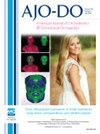清除矫正器治疗联合正颌手术:范围回顾。
IF 3
2区 医学
Q1 DENTISTRY, ORAL SURGERY & MEDICINE
American Journal of Orthodontics and Dentofacial Orthopedics
Pub Date : 2025-05-29
DOI:10.1016/j.ajodo.2025.04.018
引用次数: 0
摘要
引言:目前尚不清楚在正颌手术(OGS)中使用围手术期透明矫正器治疗(CAT)是否适合替代传统的固定矫治器,传统的固定矫治器一直是正畸准备和改进的主要手段。本范围综述评估了目前关于在OGS中使用CAT的证据的性质。方法:该综述遵循系统评价的首选报告项目和范围评价的元分析扩展指南。截至2024年4月,两名审稿人对5个电子数据库进行了系统搜索和独立筛选过程。纳入的研究类型均为同行评议的英文期刊论文,不包括文献综述、动物研究和先天性综合征。使用非随机干预研究的偏倚风险工具和Cochrane偏倚风险工具进行偏倚风险评估。结果:共纳入31项研究,298名受试者。报道了一系列不同的正畸优先和手术优先方案。患者经常有最小拥挤的III级错颌,使用Invisalign矫正器,并进行了几乎计划好的双颌手术。测量的主要结果包括治疗后完成质量、治疗持续时间、虚拟计划的准确性、术后肿胀、稳定性、牙周健康和生活质量。结论:OGS中CAT的现有证据报告了令人满意的结果。然而,由于回顾性研究设计、患者选择不明确以及客观测量方法使用不足,应谨慎解释现有证据。在常规使用CAT和OGS治疗复杂牙面畸形之前,需要对固定矫治器对照组进行前瞻性研究。本文章由计算机程序翻译,如有差异,请以英文原文为准。
Clear aligner therapy combined with orthognathic surgery: A scoping review
Introduction
It is uncertain whether using perioperative clear aligner therapy (CAT) for orthognathic surgery (OGS) is a suitable alternative to conventional fixed appliances, which has traditionally been the mainstay of orthodontic preparation and refinement. This scoping review assesses the nature of current evidence regarding the use of CAT with OGS.
Methods
The review follows Preferred Reporting Items for Systematic Reviews and Meta-Analyses Extension for Scoping Reviews guidelines. Two reviewers conducted a systematic search and independent screening process across 5 electronic databases until April 2024. Types of included studies were all peer-reviewed journal papers reported in English, excluding literature reviews, animal studies, and congenital syndromes. Risk of bias was conducted using the Risk Of Bias In Nonrandomized Studies of Interventions tool and the Cochrane risk-of-bias tool.
Results
A total of 31 studies comprising 298 participants were included. A heterogeneous array of orthodontic-first and surgery-first protocols were reported. Patients frequently had Class III malocclusions with minimal crowding, used Invisalign aligners, and underwent virtually planned bimaxillary surgery. The main outcomes measured included quality of posttreatment finishing, treatment duration, accuracy of virtual planning, postoperative swelling, stability, periodontal health, and quality of life.
Conclusions
Existing evidence on CAT in OGS reported satisfactory outcomes. However, the available evidence should be cautiously interpreted on account of retrospective study designs, unclear patient selection, and underuse of objective measures. Prospective studies with fixed appliance control groups are indicated before CAT is routinely used with OGS for complex dentofacial deformity.
求助全文
通过发布文献求助,成功后即可免费获取论文全文。
去求助
来源期刊
CiteScore
4.80
自引率
13.30%
发文量
432
审稿时长
66 days
期刊介绍:
Published for more than 100 years, the American Journal of Orthodontics and Dentofacial Orthopedics remains the leading orthodontic resource. It is the official publication of the American Association of Orthodontists, its constituent societies, the American Board of Orthodontics, and the College of Diplomates of the American Board of Orthodontics. Each month its readers have access to original peer-reviewed articles that examine all phases of orthodontic treatment. Illustrated throughout, the publication includes tables, color photographs, and statistical data. Coverage includes successful diagnostic procedures, imaging techniques, bracket and archwire materials, extraction and impaction concerns, orthognathic surgery, TMJ disorders, removable appliances, and adult therapy.

 求助内容:
求助内容: 应助结果提醒方式:
应助结果提醒方式:


